University Economics: Microeconomics Management Accounting Essay
VerifiedAdded on 2023/06/08
|8
|1377
|68
Essay
AI Summary
This economics essay addresses key microeconomic concepts, including price elasticity of demand and supply, and differentiates between elastic and inelastic demand. The essay explores how the slope of the demand curve relates to elasticity, analyzing the responsiveness of quantity demanded to price changes. It delves into the factors influencing elasticity, such as the availability of substitutes, and examines the implications of price changes on total revenue for both elastic and inelastic demand scenarios. The essay provides detailed explanations and examples to illustrate these economic principles, using relevant sources to support its arguments and providing a comprehensive understanding of the topics covered.
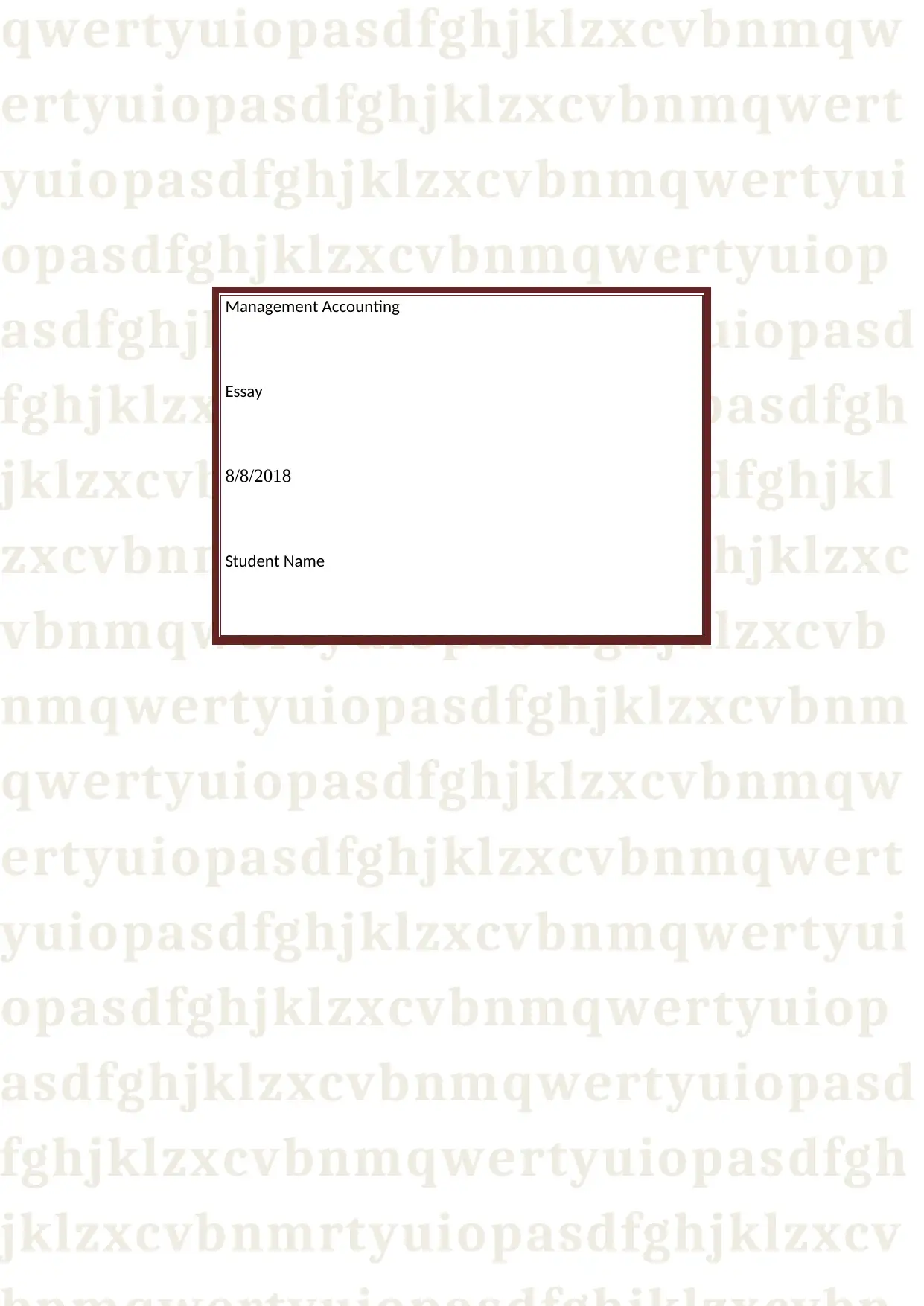
qwertyuiopasdfghjklzxcvbnmqw
ertyuiopasdfghjklzxcvbnmqwert
yuiopasdfghjklzxcvbnmqwertyui
opasdfghjklzxcvbnmqwertyuiop
asdfghjklzxcvbnmqwertyuiopasd
fghjklzxcvbnmqwertyuiopasdfgh
jklzxcvbnmqwertyuiopasdfghjkl
zxcvbnmqwertyuiopasdfghjklzxc
vbnmqwertyuiopasdfghjklzxcvb
nmqwertyuiopasdfghjklzxcvbnm
qwertyuiopasdfghjklzxcvbnmqw
ertyuiopasdfghjklzxcvbnmqwert
yuiopasdfghjklzxcvbnmqwertyui
opasdfghjklzxcvbnmqwertyuiop
asdfghjklzxcvbnmqwertyuiopasd
fghjklzxcvbnmqwertyuiopasdfgh
jklzxcvbnmrtyuiopasdfghjklzxcv
Management Accounting
Essay
8/8/2018
Student Name
ertyuiopasdfghjklzxcvbnmqwert
yuiopasdfghjklzxcvbnmqwertyui
opasdfghjklzxcvbnmqwertyuiop
asdfghjklzxcvbnmqwertyuiopasd
fghjklzxcvbnmqwertyuiopasdfgh
jklzxcvbnmqwertyuiopasdfghjkl
zxcvbnmqwertyuiopasdfghjklzxc
vbnmqwertyuiopasdfghjklzxcvb
nmqwertyuiopasdfghjklzxcvbnm
qwertyuiopasdfghjklzxcvbnmqw
ertyuiopasdfghjklzxcvbnmqwert
yuiopasdfghjklzxcvbnmqwertyui
opasdfghjklzxcvbnmqwertyuiop
asdfghjklzxcvbnmqwertyuiopasd
fghjklzxcvbnmqwertyuiopasdfgh
jklzxcvbnmrtyuiopasdfghjklzxcv
Management Accounting
Essay
8/8/2018
Student Name
Paraphrase This Document
Need a fresh take? Get an instant paraphrase of this document with our AI Paraphraser
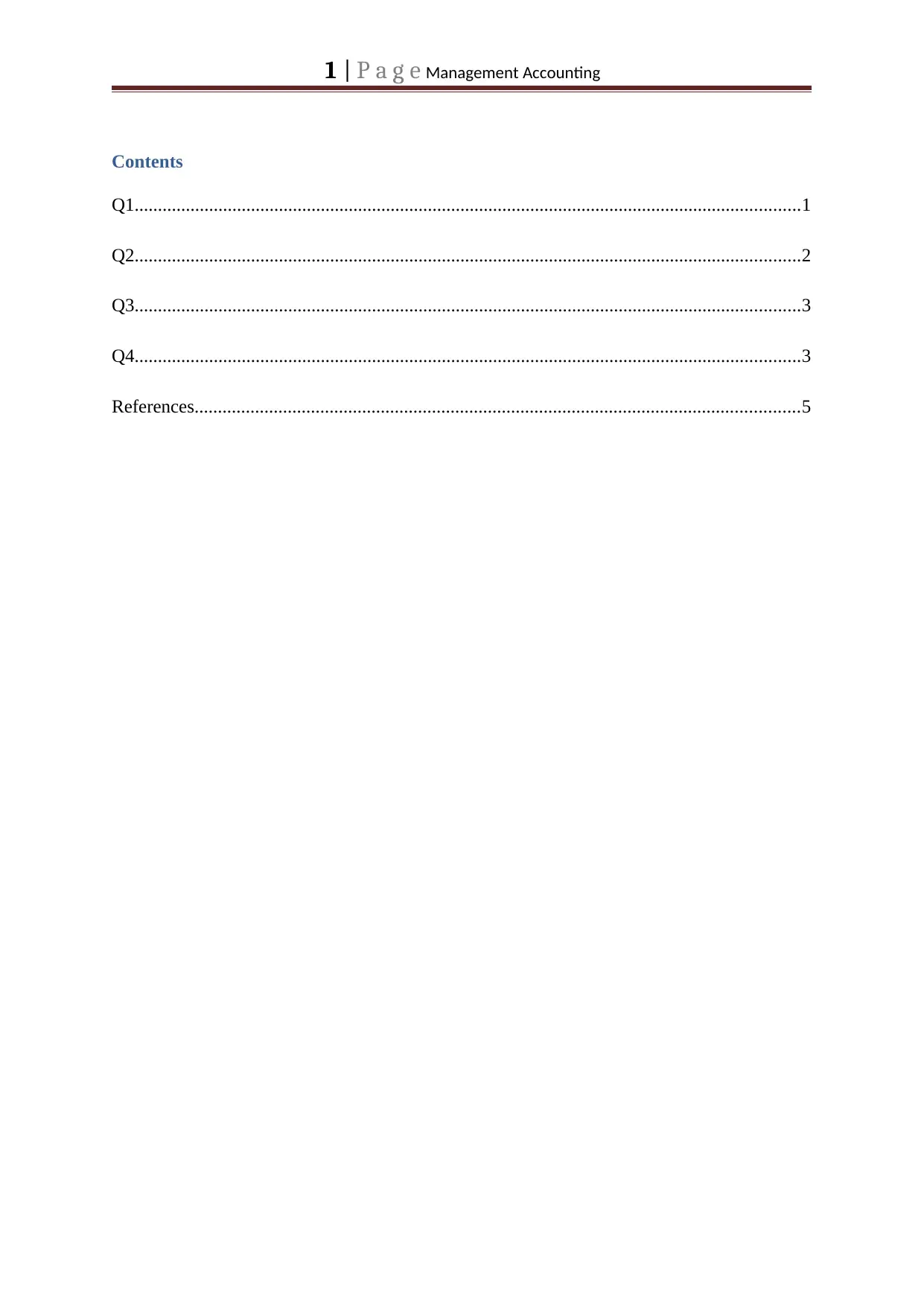
1 | P a g e Management Accounting
Contents
Q1...............................................................................................................................................1
Q2...............................................................................................................................................2
Q3...............................................................................................................................................3
Q4...............................................................................................................................................3
References..................................................................................................................................5
Contents
Q1...............................................................................................................................................1
Q2...............................................................................................................................................2
Q3...............................................................................................................................................3
Q4...............................................................................................................................................3
References..................................................................................................................................5
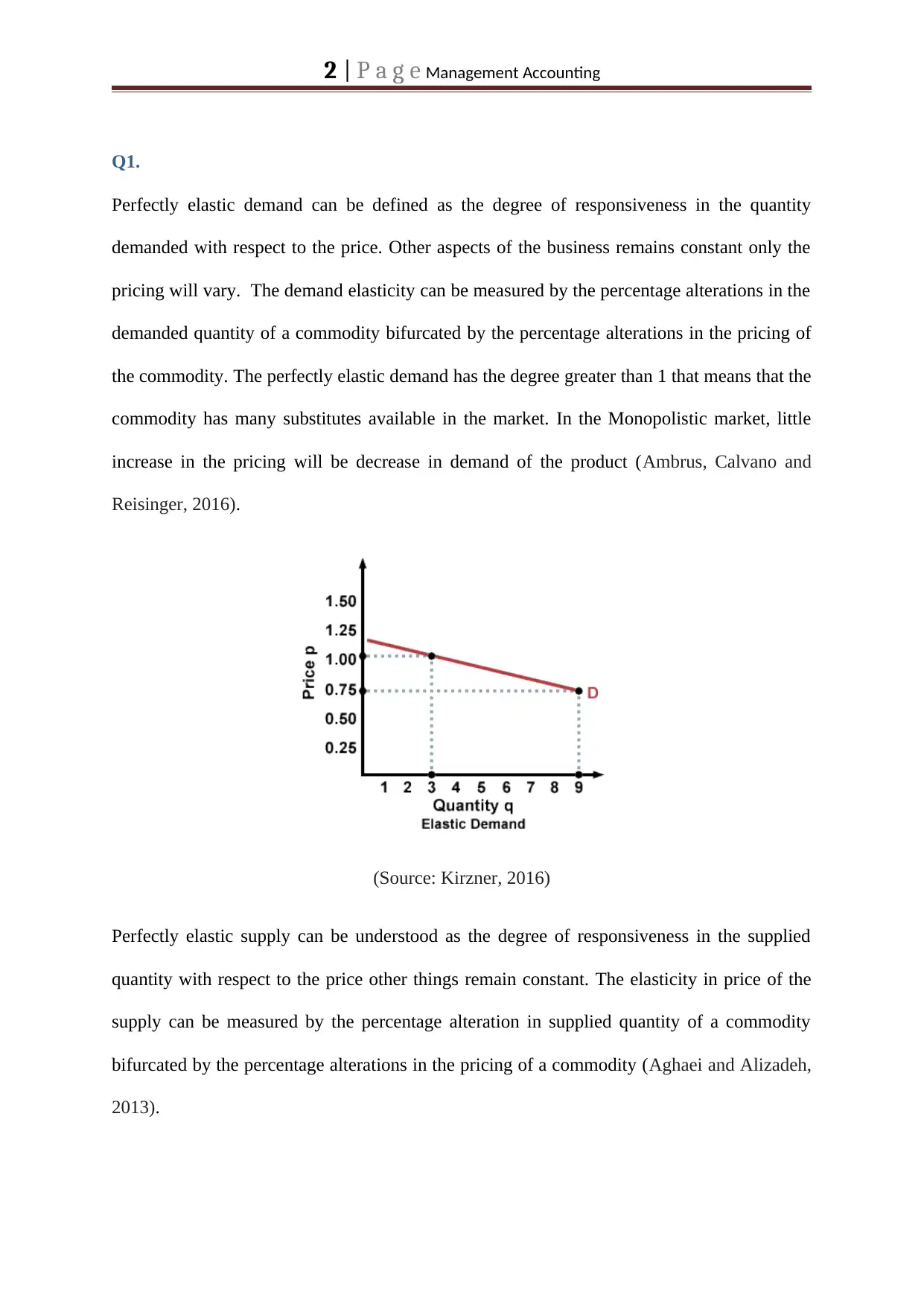
2 | P a g e Management Accounting
Q1.
Perfectly elastic demand can be defined as the degree of responsiveness in the quantity
demanded with respect to the price. Other aspects of the business remains constant only the
pricing will vary. The demand elasticity can be measured by the percentage alterations in the
demanded quantity of a commodity bifurcated by the percentage alterations in the pricing of
the commodity. The perfectly elastic demand has the degree greater than 1 that means that the
commodity has many substitutes available in the market. In the Monopolistic market, little
increase in the pricing will be decrease in demand of the product (Ambrus, Calvano and
Reisinger, 2016).
(Source: Kirzner, 2016)
Perfectly elastic supply can be understood as the degree of responsiveness in the supplied
quantity with respect to the price other things remain constant. The elasticity in price of the
supply can be measured by the percentage alteration in supplied quantity of a commodity
bifurcated by the percentage alterations in the pricing of a commodity (Aghaei and Alizadeh,
2013).
Q1.
Perfectly elastic demand can be defined as the degree of responsiveness in the quantity
demanded with respect to the price. Other aspects of the business remains constant only the
pricing will vary. The demand elasticity can be measured by the percentage alterations in the
demanded quantity of a commodity bifurcated by the percentage alterations in the pricing of
the commodity. The perfectly elastic demand has the degree greater than 1 that means that the
commodity has many substitutes available in the market. In the Monopolistic market, little
increase in the pricing will be decrease in demand of the product (Ambrus, Calvano and
Reisinger, 2016).
(Source: Kirzner, 2016)
Perfectly elastic supply can be understood as the degree of responsiveness in the supplied
quantity with respect to the price other things remain constant. The elasticity in price of the
supply can be measured by the percentage alteration in supplied quantity of a commodity
bifurcated by the percentage alterations in the pricing of a commodity (Aghaei and Alizadeh,
2013).
⊘ This is a preview!⊘
Do you want full access?
Subscribe today to unlock all pages.

Trusted by 1+ million students worldwide
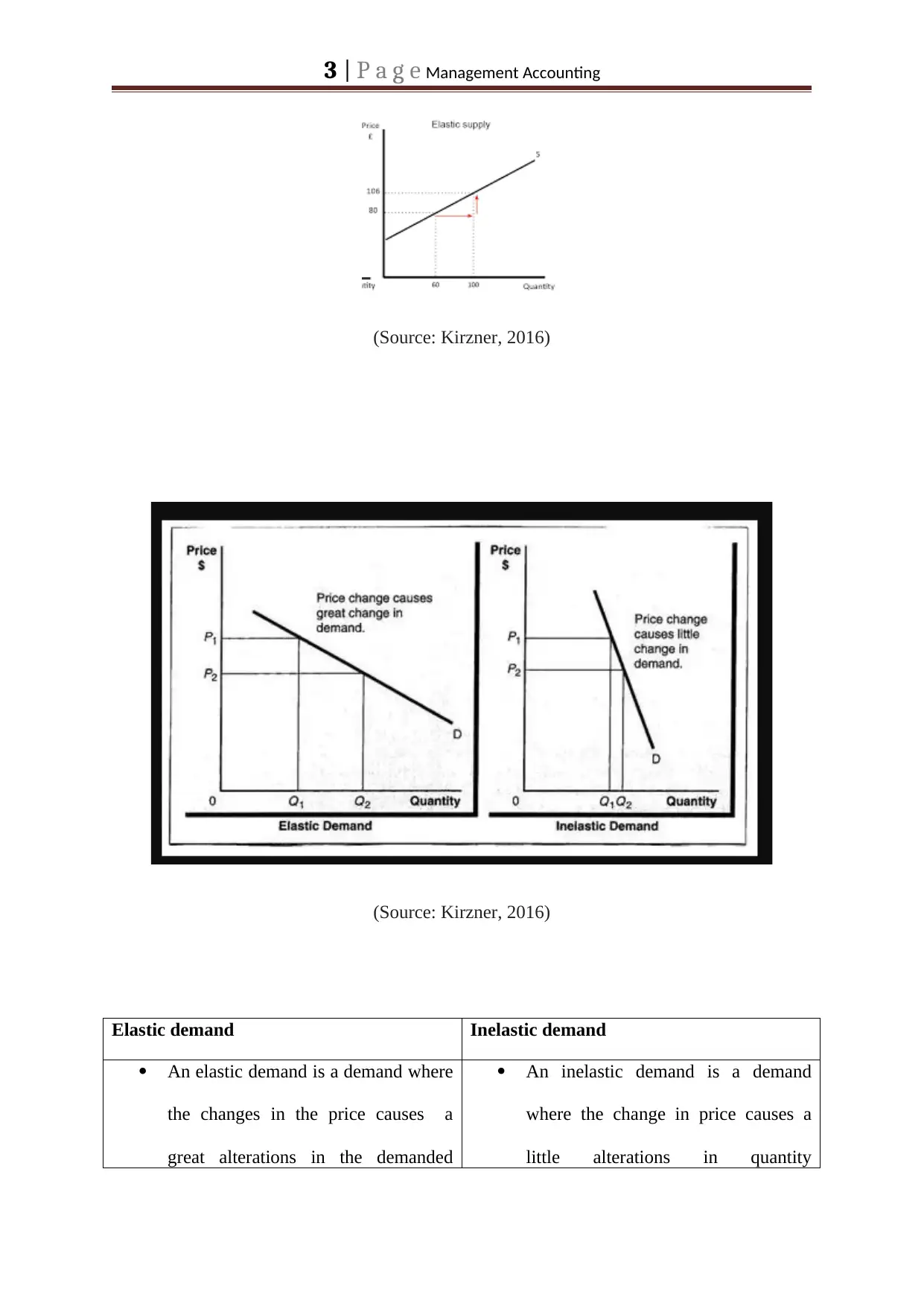
3 | P a g e Management Accounting
(Source: Kirzner, 2016)
(Source: Kirzner, 2016)
Elastic demand Inelastic demand
An elastic demand is a demand where
the changes in the price causes a
great alterations in the demanded
An inelastic demand is a demand
where the change in price causes a
little alterations in quantity
(Source: Kirzner, 2016)
(Source: Kirzner, 2016)
Elastic demand Inelastic demand
An elastic demand is a demand where
the changes in the price causes a
great alterations in the demanded
An inelastic demand is a demand
where the change in price causes a
little alterations in quantity
Paraphrase This Document
Need a fresh take? Get an instant paraphrase of this document with our AI Paraphraser
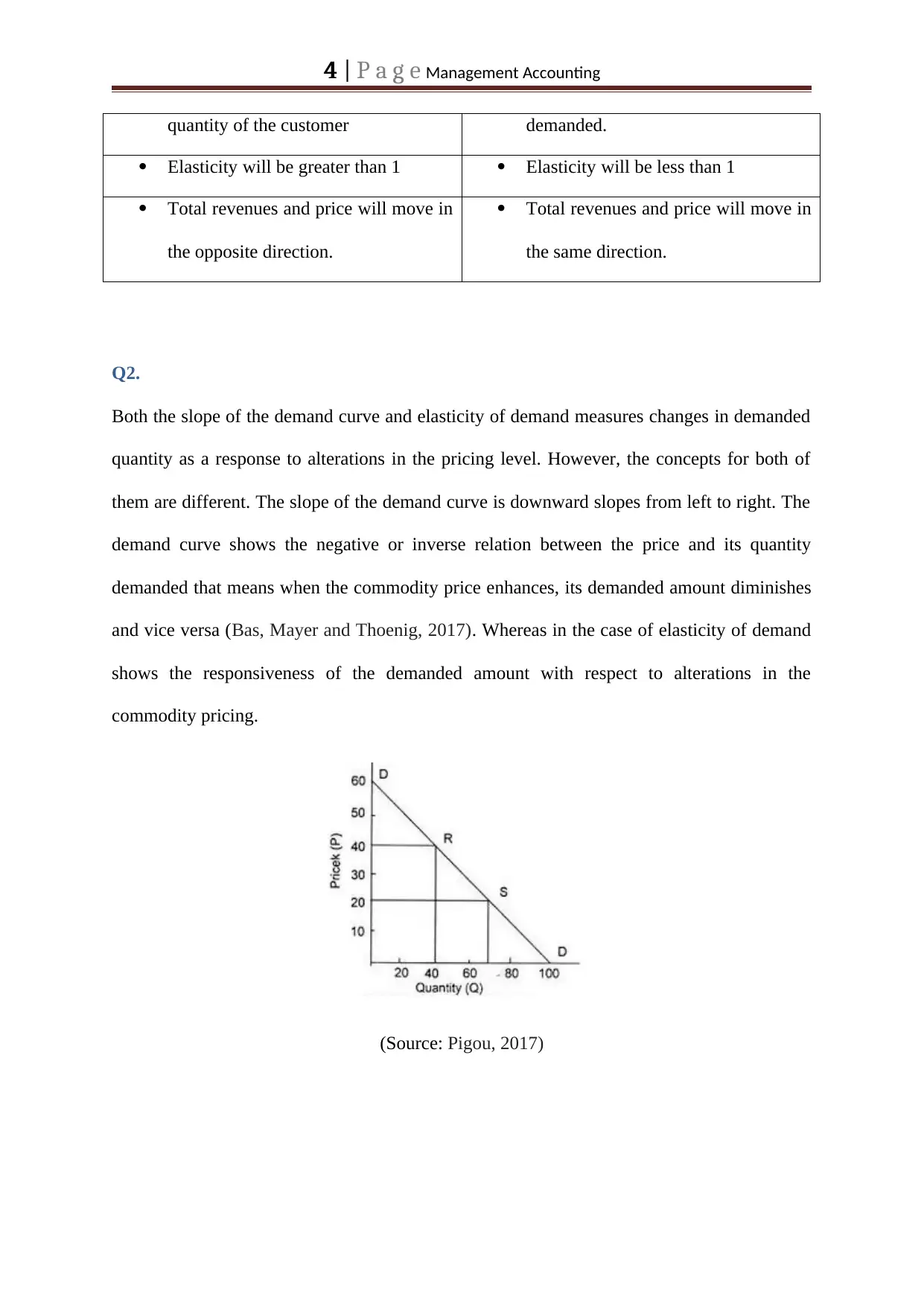
4 | P a g e Management Accounting
quantity of the customer demanded.
Elasticity will be greater than 1 Elasticity will be less than 1
Total revenues and price will move in
the opposite direction.
Total revenues and price will move in
the same direction.
Q2.
Both the slope of the demand curve and elasticity of demand measures changes in demanded
quantity as a response to alterations in the pricing level. However, the concepts for both of
them are different. The slope of the demand curve is downward slopes from left to right. The
demand curve shows the negative or inverse relation between the price and its quantity
demanded that means when the commodity price enhances, its demanded amount diminishes
and vice versa (Bas, Mayer and Thoenig, 2017). Whereas in the case of elasticity of demand
shows the responsiveness of the demanded amount with respect to alterations in the
commodity pricing.
(Source: Pigou, 2017)
quantity of the customer demanded.
Elasticity will be greater than 1 Elasticity will be less than 1
Total revenues and price will move in
the opposite direction.
Total revenues and price will move in
the same direction.
Q2.
Both the slope of the demand curve and elasticity of demand measures changes in demanded
quantity as a response to alterations in the pricing level. However, the concepts for both of
them are different. The slope of the demand curve is downward slopes from left to right. The
demand curve shows the negative or inverse relation between the price and its quantity
demanded that means when the commodity price enhances, its demanded amount diminishes
and vice versa (Bas, Mayer and Thoenig, 2017). Whereas in the case of elasticity of demand
shows the responsiveness of the demanded amount with respect to alterations in the
commodity pricing.
(Source: Pigou, 2017)
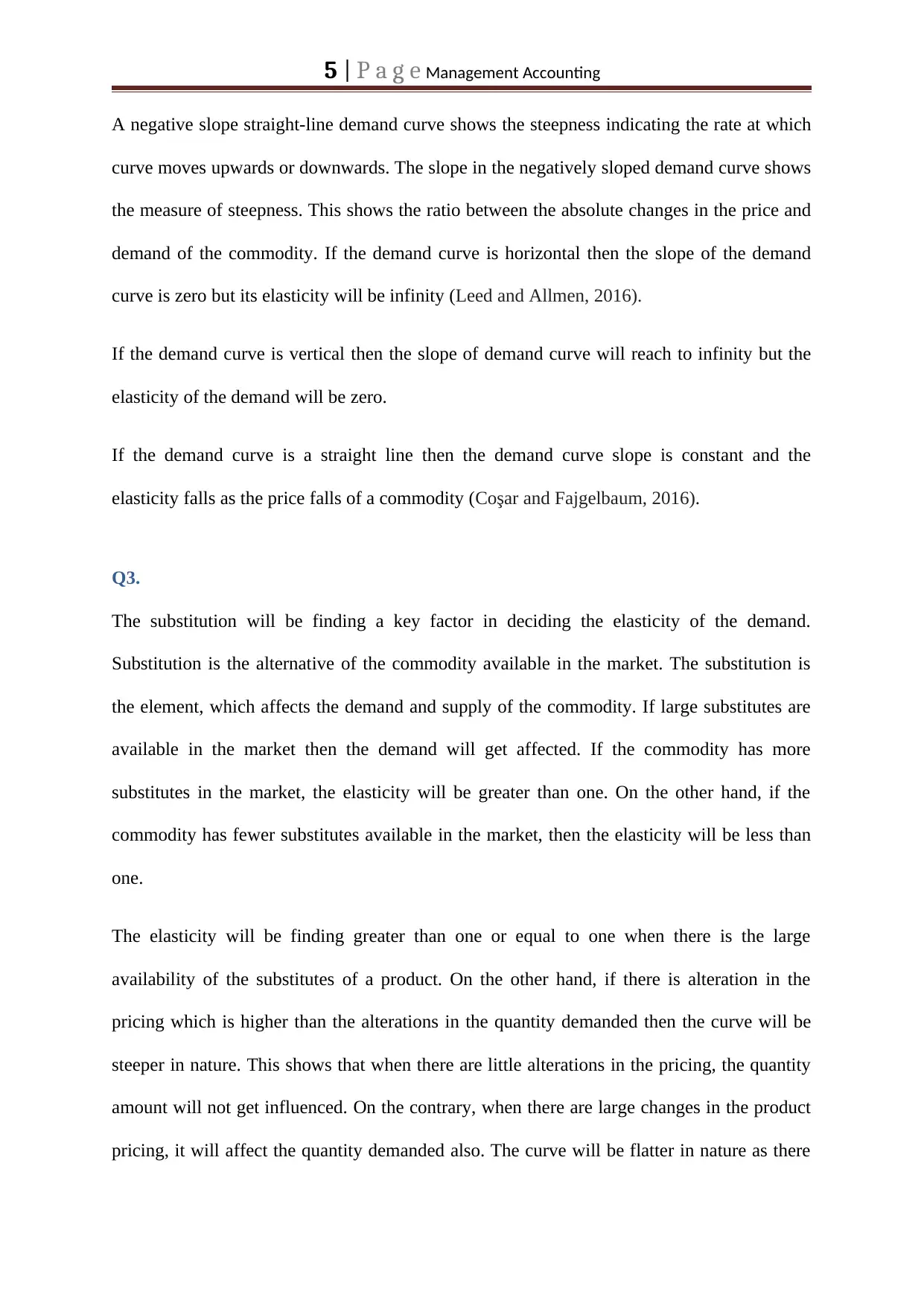
5 | P a g e Management Accounting
A negative slope straight-line demand curve shows the steepness indicating the rate at which
curve moves upwards or downwards. The slope in the negatively sloped demand curve shows
the measure of steepness. This shows the ratio between the absolute changes in the price and
demand of the commodity. If the demand curve is horizontal then the slope of the demand
curve is zero but its elasticity will be infinity (Leed and Allmen, 2016).
If the demand curve is vertical then the slope of demand curve will reach to infinity but the
elasticity of the demand will be zero.
If the demand curve is a straight line then the demand curve slope is constant and the
elasticity falls as the price falls of a commodity (Coşar and Fajgelbaum, 2016).
Q3.
The substitution will be finding a key factor in deciding the elasticity of the demand.
Substitution is the alternative of the commodity available in the market. The substitution is
the element, which affects the demand and supply of the commodity. If large substitutes are
available in the market then the demand will get affected. If the commodity has more
substitutes in the market, the elasticity will be greater than one. On the other hand, if the
commodity has fewer substitutes available in the market, then the elasticity will be less than
one.
The elasticity will be finding greater than one or equal to one when there is the large
availability of the substitutes of a product. On the other hand, if there is alteration in the
pricing which is higher than the alterations in the quantity demanded then the curve will be
steeper in nature. This shows that when there are little alterations in the pricing, the quantity
amount will not get influenced. On the contrary, when there are large changes in the product
pricing, it will affect the quantity demanded also. The curve will be flatter in nature as there
A negative slope straight-line demand curve shows the steepness indicating the rate at which
curve moves upwards or downwards. The slope in the negatively sloped demand curve shows
the measure of steepness. This shows the ratio between the absolute changes in the price and
demand of the commodity. If the demand curve is horizontal then the slope of the demand
curve is zero but its elasticity will be infinity (Leed and Allmen, 2016).
If the demand curve is vertical then the slope of demand curve will reach to infinity but the
elasticity of the demand will be zero.
If the demand curve is a straight line then the demand curve slope is constant and the
elasticity falls as the price falls of a commodity (Coşar and Fajgelbaum, 2016).
Q3.
The substitution will be finding a key factor in deciding the elasticity of the demand.
Substitution is the alternative of the commodity available in the market. The substitution is
the element, which affects the demand and supply of the commodity. If large substitutes are
available in the market then the demand will get affected. If the commodity has more
substitutes in the market, the elasticity will be greater than one. On the other hand, if the
commodity has fewer substitutes available in the market, then the elasticity will be less than
one.
The elasticity will be finding greater than one or equal to one when there is the large
availability of the substitutes of a product. On the other hand, if there is alteration in the
pricing which is higher than the alterations in the quantity demanded then the curve will be
steeper in nature. This shows that when there are little alterations in the pricing, the quantity
amount will not get influenced. On the contrary, when there are large changes in the product
pricing, it will affect the quantity demanded also. The curve will be flatter in nature as there
⊘ This is a preview!⊘
Do you want full access?
Subscribe today to unlock all pages.

Trusted by 1+ million students worldwide
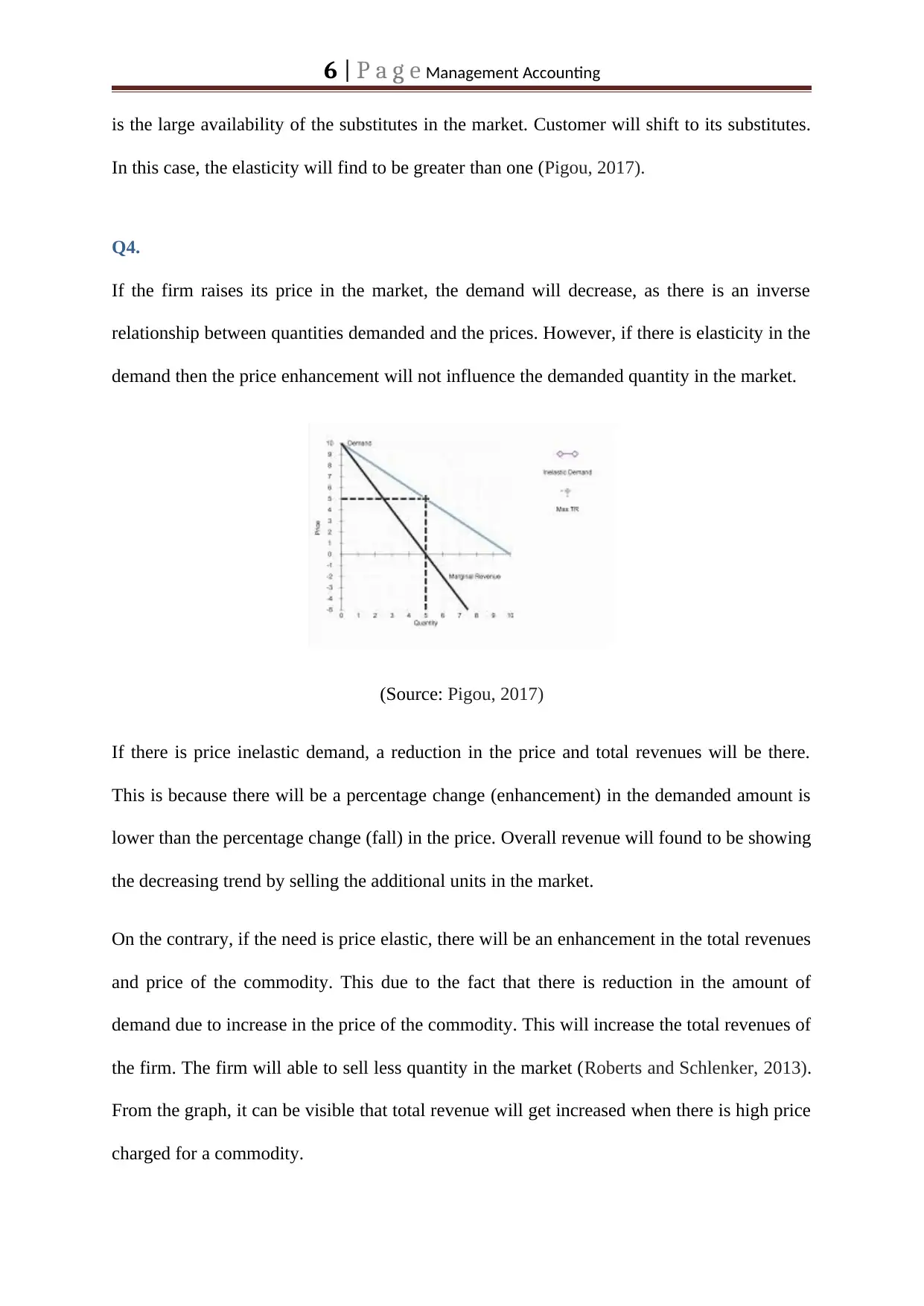
6 | P a g e Management Accounting
is the large availability of the substitutes in the market. Customer will shift to its substitutes.
In this case, the elasticity will find to be greater than one (Pigou, 2017).
Q4.
If the firm raises its price in the market, the demand will decrease, as there is an inverse
relationship between quantities demanded and the prices. However, if there is elasticity in the
demand then the price enhancement will not influence the demanded quantity in the market.
(Source: Pigou, 2017)
If there is price inelastic demand, a reduction in the price and total revenues will be there.
This is because there will be a percentage change (enhancement) in the demanded amount is
lower than the percentage change (fall) in the price. Overall revenue will found to be showing
the decreasing trend by selling the additional units in the market.
On the contrary, if the need is price elastic, there will be an enhancement in the total revenues
and price of the commodity. This due to the fact that there is reduction in the amount of
demand due to increase in the price of the commodity. This will increase the total revenues of
the firm. The firm will able to sell less quantity in the market (Roberts and Schlenker, 2013).
From the graph, it can be visible that total revenue will get increased when there is high price
charged for a commodity.
is the large availability of the substitutes in the market. Customer will shift to its substitutes.
In this case, the elasticity will find to be greater than one (Pigou, 2017).
Q4.
If the firm raises its price in the market, the demand will decrease, as there is an inverse
relationship between quantities demanded and the prices. However, if there is elasticity in the
demand then the price enhancement will not influence the demanded quantity in the market.
(Source: Pigou, 2017)
If there is price inelastic demand, a reduction in the price and total revenues will be there.
This is because there will be a percentage change (enhancement) in the demanded amount is
lower than the percentage change (fall) in the price. Overall revenue will found to be showing
the decreasing trend by selling the additional units in the market.
On the contrary, if the need is price elastic, there will be an enhancement in the total revenues
and price of the commodity. This due to the fact that there is reduction in the amount of
demand due to increase in the price of the commodity. This will increase the total revenues of
the firm. The firm will able to sell less quantity in the market (Roberts and Schlenker, 2013).
From the graph, it can be visible that total revenue will get increased when there is high price
charged for a commodity.
Paraphrase This Document
Need a fresh take? Get an instant paraphrase of this document with our AI Paraphraser
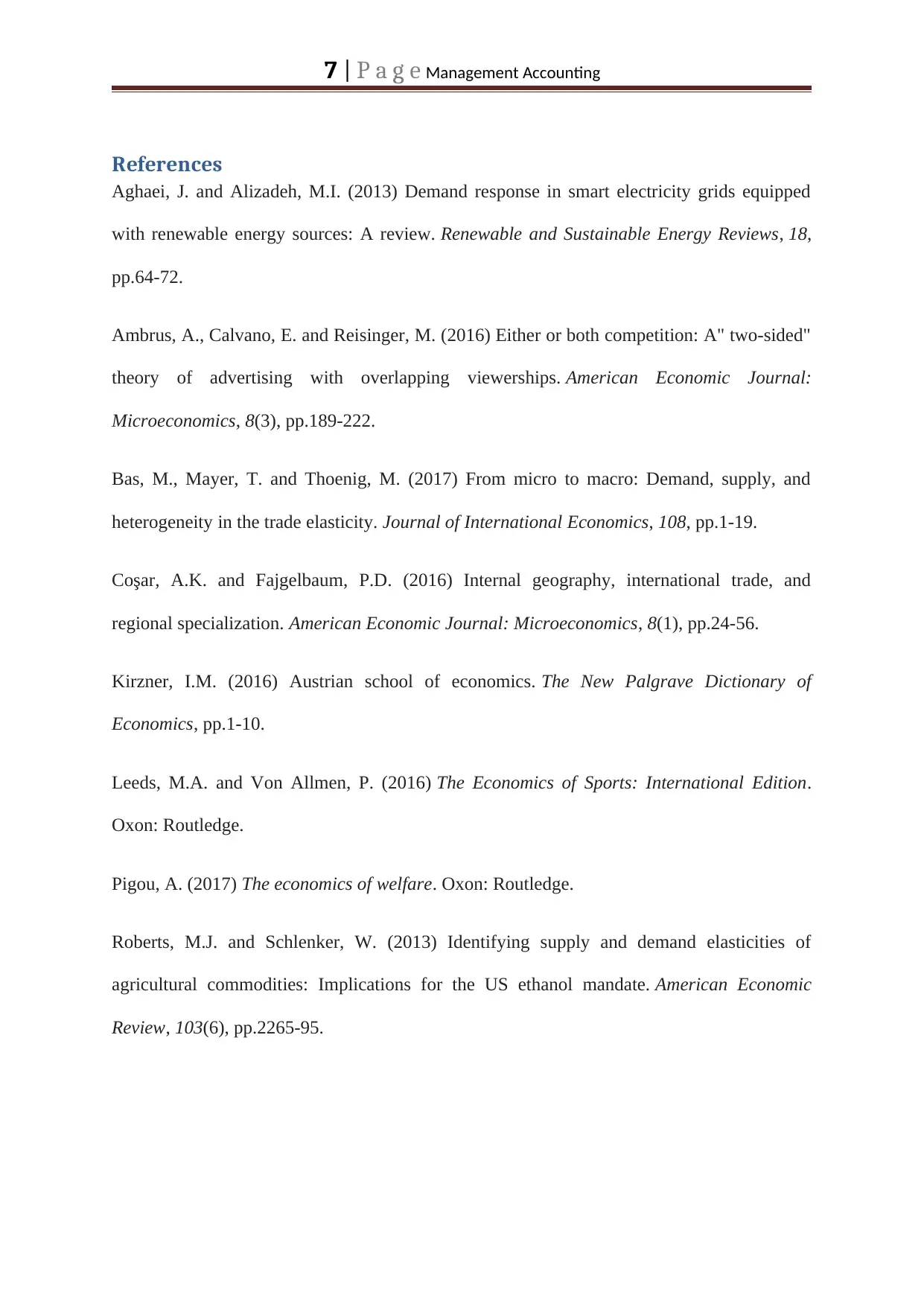
7 | P a g e Management Accounting
References
Aghaei, J. and Alizadeh, M.I. (2013) Demand response in smart electricity grids equipped
with renewable energy sources: A review. Renewable and Sustainable Energy Reviews, 18,
pp.64-72.
Ambrus, A., Calvano, E. and Reisinger, M. (2016) Either or both competition: A" two-sided"
theory of advertising with overlapping viewerships. American Economic Journal:
Microeconomics, 8(3), pp.189-222.
Bas, M., Mayer, T. and Thoenig, M. (2017) From micro to macro: Demand, supply, and
heterogeneity in the trade elasticity. Journal of International Economics, 108, pp.1-19.
Coşar, A.K. and Fajgelbaum, P.D. (2016) Internal geography, international trade, and
regional specialization. American Economic Journal: Microeconomics, 8(1), pp.24-56.
Kirzner, I.M. (2016) Austrian school of economics. The New Palgrave Dictionary of
Economics, pp.1-10.
Leeds, M.A. and Von Allmen, P. (2016) The Economics of Sports: International Edition.
Oxon: Routledge.
Pigou, A. (2017) The economics of welfare. Oxon: Routledge.
Roberts, M.J. and Schlenker, W. (2013) Identifying supply and demand elasticities of
agricultural commodities: Implications for the US ethanol mandate. American Economic
Review, 103(6), pp.2265-95.
References
Aghaei, J. and Alizadeh, M.I. (2013) Demand response in smart electricity grids equipped
with renewable energy sources: A review. Renewable and Sustainable Energy Reviews, 18,
pp.64-72.
Ambrus, A., Calvano, E. and Reisinger, M. (2016) Either or both competition: A" two-sided"
theory of advertising with overlapping viewerships. American Economic Journal:
Microeconomics, 8(3), pp.189-222.
Bas, M., Mayer, T. and Thoenig, M. (2017) From micro to macro: Demand, supply, and
heterogeneity in the trade elasticity. Journal of International Economics, 108, pp.1-19.
Coşar, A.K. and Fajgelbaum, P.D. (2016) Internal geography, international trade, and
regional specialization. American Economic Journal: Microeconomics, 8(1), pp.24-56.
Kirzner, I.M. (2016) Austrian school of economics. The New Palgrave Dictionary of
Economics, pp.1-10.
Leeds, M.A. and Von Allmen, P. (2016) The Economics of Sports: International Edition.
Oxon: Routledge.
Pigou, A. (2017) The economics of welfare. Oxon: Routledge.
Roberts, M.J. and Schlenker, W. (2013) Identifying supply and demand elasticities of
agricultural commodities: Implications for the US ethanol mandate. American Economic
Review, 103(6), pp.2265-95.
1 out of 8
Related Documents
Your All-in-One AI-Powered Toolkit for Academic Success.
+13062052269
info@desklib.com
Available 24*7 on WhatsApp / Email
![[object Object]](/_next/static/media/star-bottom.7253800d.svg)
Unlock your academic potential
Copyright © 2020–2025 A2Z Services. All Rights Reserved. Developed and managed by ZUCOL.




